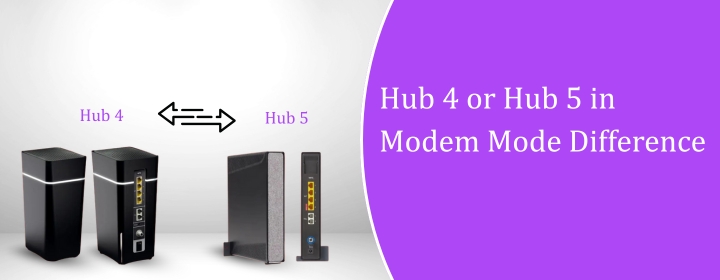Hub 4 or Hub 5 in Modem Mode Difference

When people talk about Virgin routers, the question often comes up: Should you stick with the Hub 4 or go for the Hub 5 in modem mode? The answer is not always clean because both can work fine, but there are some key differences. If you are planning to use your own third-party router and just need the Virgin box to pass the connection through, knowing what changes between Hub 4 and Hub 5 can save time and frustration.
Whenever there is some discussion with respect to the Virgin router, there is always a choice between Hub 4 and Hub 5 in modem mode. The answer can not be well defined, as both work perfectly, but there are some major differences. In case you are using 3rd third-party router and in need of a Virgin box to pass the connection through. So, knowledge of the change between the hub 4 and hub 5 makes a lot of difference, and you will end up saving lots of time.
What Modem Mode Actually Means
First, a quick note. Modem mode on a Virgin router turns off the Wi-Fi and all the “router” features. The box stops handling multiple devices, firewalls, and all that. It just acts as a simple modem, passing the internet straight to your own router.
You normally switch it on by going to Virgin router login (type 192.168.0.1 in your browser) and hitting the setting for modem mode. The hub then reboots and comes back with just one active port, usually the first LAN port.
So, if you are running mesh Wi-Fi or a gaming router, modem mode is what you want. It cuts out the double NAT (network address translation) issue and avoids clashing settings.
Hub 4 in Modem Mode
No doubt that Hub 4 is good, but it comes with a few limits.As it is based on the older hardware and does not support wifi 6 in modem mode. Which is not the concern, as you are not using the wifi anyway.
Here’s what people usually notice with Hub 4 in modem mode:
- One active port only. The rest are dead once you switch.
- Speed handling. It can manage Virgin’s Gig1 speeds, but sometimes when it is pushed hard, then higher level of discontinuity has been observed.
- Stable enough. Once it’s set, it usually stays solid. But if you are running lots of devices behind your own router, you may notice the Hub 4 sometimes struggles with a certain kind of load.
- IPv6. Support is limited compared to newer gear. Furthermore, some setups need workarounds.
In short, the Hub 4 does the job, but it can feel outdated when paired with newer routers.
Hub 5 in Modem Mode
Now, the Hub 5 in modem mode comes with updated hardware. Even though you will not be using its built-in Wi-Fi. But the chipset inside makes all the difference.
Key points with Hub 5 in modem mode:
- Faster ports. It has a 2.5Gbps LAN port, which means if your third-party router supports multi-gig, you can actually push more than 1Gbps. This is a big upgrade over the Hub 4.
- Better stability. Fewer reports of random dropouts compared to Hub 4 when under heavy load.
- Future-proof. If Virgin upgrades speeds later, the Hub 5 is already built to handle them.
- IPv6 ready. It plays nicer with modern networks, which means less messing up if you want IPv6 live.
The main annoyance? Some people still report the modem mode reboot taking longer on Hub 5. And occasionally, the box doesn’t hand over the connection cleanly until you power supply both the hub and your own router.
Real-World Difference Between Hub 4 and Hub 5
So, what does all this mean if you’re just trying to decide?
- If you’re on a lower Virgin package (say 100–350 Mbps) and you already have a Hub 4, switching to Hub 5 just for modem mode won’t change much. Your router will still run the show.
- If you’re on Gig1 or higher, Hub 5 makes more sense. That 2.5Gbps port gives breathing room. Even if you don’t have a 2.5Gbps router today, you may in the future.
- Stability feels slightly better on Hub 5. Gamers and people who stream in 4K notice smoother performance during peak times.
- Both need a Virgin router login to enable modem mode, and both limit you to one active port once enabled.
It won’t be wrong to say that Hub 4 works perfectly, but Hub 5 is even better.
Things to be Kept in Mind
- Virgin support. If you ring Virgin with your hub in modem mode, they may ask you to switch it back before troubleshooting. Don’t be surprised.
- Router setup. Always reboot your own router after enabling modem mode on the hub, or it may not grab the connection.
- Placement. Even though the hub’s Wi-Fi is off, keep it in a cool, open spot. These boxes run hot if tucked away.
- Backup plan. If your router fails, you can switch modem mode off through the Virgin router modem mode and login. Then use the hub as a normal router again. Handy in emergencies.
Final Word
Both the Hub 4 and 5 work perfectly in the modem mode. In case you already own a Hub 4 and speed is also fine, then there is no rush for the upgrade. But in case you are looking for the most stable and cleanest setup for Gig 1 or higher, you should give a try to Hub 5 in modem mode. As the extra port speed, smoother performance, and better chipset are all that make the difference.
At the end of the day, modem mode is about letting your own router work properly.. The Virgin hub is just the middle point.. Although Hub 4 can handle it. Whereas Hub 5 makes it feel less like a compromise.

 Leo Karlo / September 19, 2025
Leo Karlo / September 19, 2025